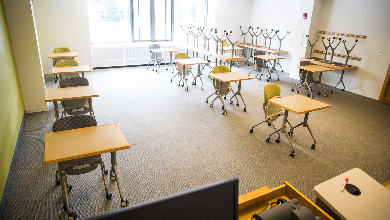
We care about our students and will continue to do everything we can to help them learn in the best environment possible.
At Bridgewater State University the focus has always been on helping students find their own definition of success, even in the middle of a global pandemic.
During COVD-19, a dedicated group has been working behind the scenes, ensuring all BSU classrooms are not only physically safe for those on campus, but also available to students learning remotely.
“We are making sure that every student has a safe opportunity to learn, that students are comfortable on campus, and if they can’t come to campus, we will make sure there are options for them as well,” said Dr. David Crane, dean of Academic Affairs. “Every step has been taken to be inclusive.”
According to Mark Carmody, assistant vice president of Operations, students attending in-person classes will face reduced seating, allowing for six-foot distancing.
“Bear Buckets” full of disinfectant spray, hand sanitizer, masks and paper towels for students and faculty to use are also available in each room. Reminders to students to wear face masks are also part of the new protocol.
Circulation, how students and faculty enter and exit a room safely, was also taken into account in making the adjustments. Additional signage has been installed to help students and faculty understand where they can sit, and tape now outlines which direction in hallways they should walk.
“It’s challenging but the university has established a good protocol, we are taking a very conservative approach for space planning to make sure our students and instructors are safe,” said Chris Drowne, project manager of Operations and Capital Planning.
Because many students will be off campus and learning remotely this fall, the Information Technology Department has installed equipment, such as cameras and microphones, in classrooms so that BSU can offer “hyflex” learning, which combines elements of a face-to-face class and a live-stream video in real time. Sessions are also recorded and made available for enrolled students.
In short, students will either learn through synchronous learning, when the course is taught online and happens in real time or, asynchronous, when learning occurs through remote channels without real-time interaction.
Tools, such a safe swipe cards will also be used to perform contact tracing. Students on campus will be asked to swipe theirs cards upon entering every building, said Lisa Grosshart, director of information technology.
“All of our efforts are to keep everyone safe,” Carmody said. “We care about our students and will continue to do everything we can to help them learn in the best environment possible.”
Do you have a BSU story you'd like to share? Email stories@bridgew.edu